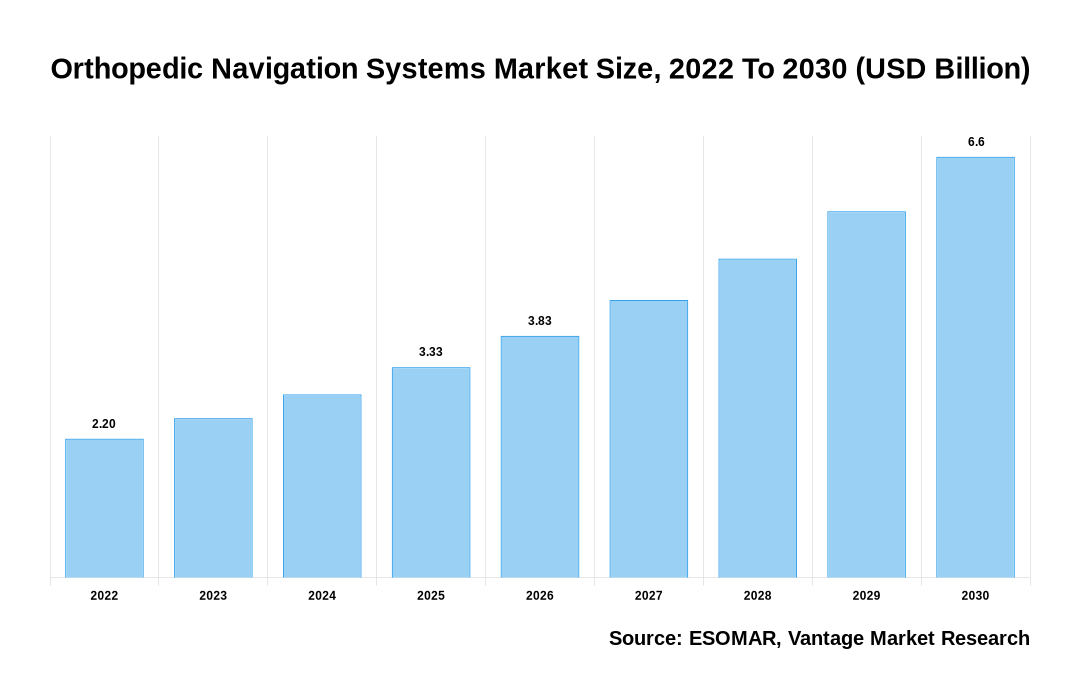Global Orthopedic Navigation Systems Market
As stated in our extensive report, the Global Orthopedic Navigation Systems Market accounted for USD 2.2 Billion in 2022 and is projected to reach a value of USD 6.6 Billion by 2030.
Adopting minimally invasive procedures, the rising prevalence of orthopedic disorders, and technical improvements contribute to the considerable growth of the Orthopedic Navigation Systems market. The market is anticipated to rise over the next few years due to ongoing technological advancements and increased demand for better surgical outcomes.
The market for Orthopedic Navigation Systems is significantly growing due to several causes. The rising incidence of orthopedic diseases and the global aging population are two major contributors. Age-related increases in the prevalence of musculoskeletal conditions such as osteoarthritis and degenerative joint illnesses increase the need for orthopedic surgery. Orthopedic Navigation Systems give surgeons state-of-the-art instruments for precisely aligning and positioning implants, improving surgical outcomes and patient satisfaction.
The Orthopedic Navigation Systems market is expanding due to technological developments. Orthopedic procedures have been transformed by innovations like real-time tracking, image-guided navigation, and 3D visualization, which enable greater accuracy and better surgical planning. Thanks to these technological developments, increasing their popularity among medical practitioners, Orthopedic Navigation Systems are now much more effective and efficient.
Click To Get a Free Sample On the Research Study

Additionally, the increasing emphasis on minimally invasive surgical techniques drives the market growth of Orthopedic Navigation Systems. Compared to open surgeries, minimally invasive procedures provide several advantages, including less tissue stress, faster recovery times, and better patient results. Orthopedic Navigation Systems enable precise and accurate treatments during minimally invasive operations and deliver the best outcomes.
Key factors influencing Orthopedic Navigation Systems Market Growth
The growth of the global Orthopedic Navigation Systems market can be attributable to the following:
- Increasing prevalence of orthopedic conditions: The market for Orthopedic Navigation Systems is significantly influenced by the increased prevalence of orthopedic conditions such as osteoarthritis, degenerative joint illnesses, and fractures. With an aging population and an increase in the majority of musculoskeletal diseases, there is an increasing demand for cutting-edge technology that can improve surgical outcomes and patient quality of life.
- Technological developments: The ongoing development of Orthopedic Navigation Systems technologies have been a significant factor in the market’s expansion. Orthopedic procedures are now more precise and accurate thanks to advancements in image-guided navigation, robotic surgery, and real-time tracking. These tools help surgeons execute precise implant positioning and alignment, improve surgical planning, and lower the risk of problems.
- Growing support for lower-risk procedures: The market for Orthopedic Navigation Systems is driven by the rising popularity of minimally invasive surgical techniques. Reduced tissue stress, smaller incisions, shorter hospital stays, and faster recovery times are advantages of minimally invasive surgical methods.
- Infrastructure growth and rising healthcare costs: The market for Orthopedic Navigation Systems is expanding due to increasing healthcare spending and the creation of cutting-edge healthcare infrastructure, particularly in developing nations. Governments and healthcare organizations are investing in modernizing their facilities and implementing advanced technologies to enhance patient care.
North America Region to Take Over the Market
The North America is anticipated to dominate the worldwide Orthopedic Navigation Systems market throughout the projected time frame. Several factors influence this forecast. North America has a developed healthcare system and a high cutting-edge medical technology uptake rate. The region’s position is further bolstered by many significant competitors in the Orthopedic Navigation Systems industry. The need for advanced navigation systems in orthopedic surgery is fueled by North America abundance of outstanding medical facilities, research centers, and expert surgeons.
Effective Orthopedic Navigation Systems are also required because of the rising prevalence of orthopedic disorders in the North America population, such as osteoarthritis and sports injuries. The need for orthopedic operations is partly fueled by the region’s aging, musculoskeletal disorder-prone population. Additionally, expanding healthcare spending and favorable reimbursement rules in North America encourage the use of cutting-edge medical technologies and boost market expansion.
Conclusion
An increase in orthopedic problems, and rising acceptance of minimally invasive surgical techniques due to technological improvements, the market for Orthopedic Navigation Systems is expanding rapidly. These factors drive the need for sophisticated navigation systems that provide precise and accurate guidance during orthopedic surgery. The market is moving toward better surgical results, fewer problems, and higher patient satisfaction. The Orthopedic Navigation Systems market is anticipated to grow as the healthcare sector prioritizes innovation and patient-centered care, giving healthcare professionals cutting-edge technologies to perform better surgical interventions and enhance patient outcomes.
The well-known players of the Global Orthopedic Navigation Systems market include Johnson & Johnson Services Inc. (U.S.), Stryker Corp. (U.S.), Zimmer Biomet (U.S.), B. Braun Melsungen AG (Germany), Medtronic PLC (Ireland), Amplitude Surgical (France) and others.
![[Market Research Reports] – Research Google News Blog | VMR.Biz](https://www.vmr.biz/wp-content/uploads/2022/12/logo-removebg-preview.png)











